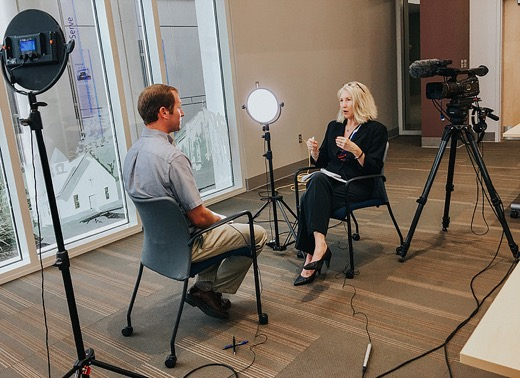
Laure Quinlivan, a board member of the nonprofit Women in Film and a former Cincinnati City Council member, is no stranger to this process. She found it tricky to fund her 26-minute indie documentary project Cincinnati LEEDS the Nation. The film is about the Cincinnati Police Department’s District 3 headquarters on the West Side, which became the first net-zero energy police station in the United States in 2015.
Early on in the fundraising process, PBS offered to air her doc on local PBS affiliate CET as long as she raised the money to produce it herself. It took her a year to raise all the funds and CET aired the film in November 2017.
So far, the doc has had four local screenings. Most recently, the local chapter of the Sierra Club hosted an event and screening on Jan. 7, and during this year’s Earth Day in April and National Police Week in May, the National Educational Telecommunications Association will distribute her film nationally to public TV stations, which she says will be good exposure — but that deal came with a catch.
“I had to raise more money,” she says. “They had me change the name of the film so that it has a broader appeal beyond Cincinnati. And I had to pay someone to do station relations.”
The new title in question? Blue Goes Green: Net Zero Police Station. Additional edits — changing the title card in the video — were also made, as well as paying NETA to put it on their satellite.
Overall, Quinlivan has had to raise funds “in the hundred-thousand-dollar range” for her film. “I’m always raising money just to get it seen,” she says. “It’s OK, because I never wanted to do it to make money, anyway. Documentary work is not a money-making venture.”
Originally founded in 1973 Los Angeles by Tichi Wilkerson Kassel, Women in Film didn’t come to Cincinnati until 2016 when Quinlivan shepherded a chapter. At the time — while working on Cincinnati LEEDs the Nation — she had begun to connect with other locals creating documentaries independently in Cincinnati.
As an organization, Women in Film provides resources — be it a network, scholarship or events — and also works to address gender disparities within the industry. The stated goal is to advance to creative and professional development of women in the region working in film, television and digital media.
“I was starting to meet other women who did documentaries. And we just thought, ‘Yeah, we could use a chapter here just to support women in the industry,”’ Quinlivan says. “Women have had to fight for access, from the government to business. It’s no different in film. Generally speaking, we’re in the minority.”
Nationally, a report from the Center for the Study of Women in Television and Film at San Diego State University found that women made up only 8 percent of directors on the top 250 films of 2018, which is down 11 percent from 2017.
Locally, Kristen Schlotman, the executive director of Film Cincinnati, says that “in 2011 about 1/10th of film crews were women; now it’s over a third.” While this might sound promising, men have directed most of the film and TV projects that receive tax incentives through the film office.
“For some reason, film is not considered an art form here (in Greater Cincinnati) like it is in other places,” Quinlivan says.
The Greater Cincinnati Foundation — which invests in projects across the region — does not fund films. Comparatively, the Cleveland Greater Foundation does fund film.
One of Quinlivan’s initial sponsors for Cincinnati LEEDS the Nation was the Greater Cincinnati Energy Alliance, who helped her obtain funding from Frisch’s and the Stephen H. Wilder Foundation, the latter of which has a $24,000 yearly budget to fund documentaries. For the national push of the doc, local donors Green Umbrella, Green Energy Ohio, Kraft Electrical and Feldkamp Enterprises donated funds.
Cincinnati’s chapter of Women in Film now has almost 100 members — both men and women (an annual membership costs $10 for students or $50 for professionals). And in October 2018, the group hosted a how-to-fund-your-project panel discussion featuring local and regional nonprofits, who took questions from inspiring filmmakers.
“The event was an important first step in trying to change the equation,” Quinlivan says. “I don’t know if it’ll change, but I think talking about it and making people aware of how thing are, is a good way to start.”
For more info on Women in Film Cincinnati and upcoming events check out wifcincinnati.org.

